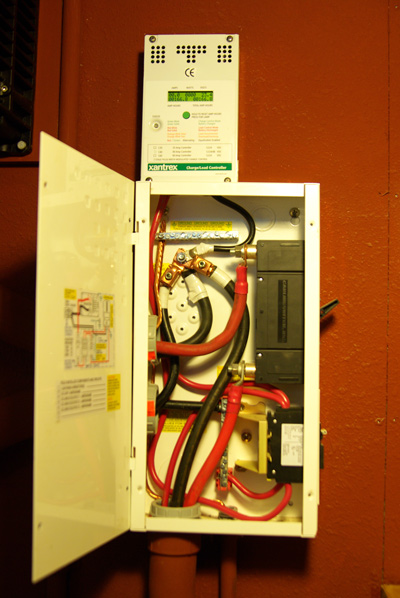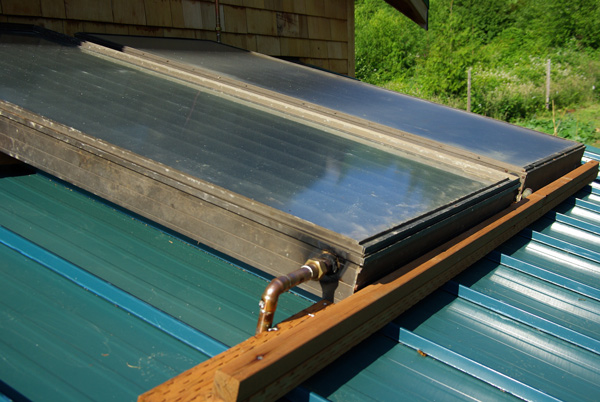
Three 165 watt 24V panels provide about 2500 watts per day when it's sunny. This is about the same output as our tiny hydro generator which produces 100 watts continuous in the wet months. This is not a lot of electricity. Most people size a system based on their use, we sized ours based on what we could afford!

This is our off-grid electricity control center, power is fed from solar panels or the hydro generator to the charge controller (little white box), and then to the batteries (wood box), and then to the inverter (black box), with breakers in between everything. The large white box is our on demand propane water heater, it has been shut off since we installed wood heated hot water. Our system cost about 10,000 dollars total and provides enough electricity to run lights, computers, and small appliances.

This is the inside of the Midnite Solar Mini DC combiner and switch box. One of the biggest problems with installing your own off-grid electric system is component compatibility. All connections must be made inside code approved, UL listed boxes, all component connected by conduit. Every connection must be made in a code approved manner. This seemed like no big deal until I tried to do it and discovered how difficult it really was. This innovative and reasonably priced box made it possible. Above are the connections for solar, things got a lot more crowded with the hydro disconnects in there.

This is our tiny hydro generator, purchased from HI-Power Hydro, essentially a brushless DC motor rigged to run backwards. We don't have much flow (30gpm) or drop (18psi) so this little guy only puts out about a hundred watts, but it's enough to carry us through the winter. In the summer we switch to solar panels exclusively. Total cost for this system was about 2,000 dollars.

This is the ultimate quick and simple solar hot water installation. Two salvaged flat plate collectors from the 1970's sit at a natural angle on our porch roof and the convection drives the flow of water into the storage tank on the other side of the wall. In many ways you couldn't do worse than this installation, the panels are old and full of air leaks with outdated insulation. The selective glass on one of them is facing the wrong way! All my copper piping is uninsulated, the panels are not at an optimum sun angle, and the whole system is undersized for this climate. Despite all this, they work fantastic! On any sunny day between equinoxes the water is actually too hot, a partial sun day gives us good hot water, and a day with light cloud cover will still produce warm water that takes little extra energy to heat. In the deep winter trees block our sun, so we'll drain the system and let the woodstove heat the water, which it will do anyways because the woodstove is also our cookstove and our home heater.
I could have never imagined how well this simple, cheap system performs, and even the expensive, efficient solar heater with all the bells and whistles are not that expensive. It has left me wondering why everyone doesn't have these on their house? Solar water will not meet all our needs in a coastal climate but it will heat at least half the hot water in a year. With the water heater being the largest energy hog in the house, who wouldn't want to save half that money?